Table of Content
History of the Complex
The Strategic Location of the Giza Pyramids
Unveiling the Sacred Purpose of the Giza Pyramids
The Celestial Layout of the Giza Pyramids Complex
Pyramid Construction: The Orion Connection
The Great Pyramid of King Khufu
King Khafra's Pyramid
King Menkaure's Pyramid
The Great Sphinx: A Majestic of Ancient Egypt
Giza Pyramids Complex
The Giza Pyramids Complex is a shining symbol of human creativity and relentless industry. This monumental site stands as a tribute to humanity's limitless potential and the extraordinary heights of our achievements.
Our journey takes you through the awe-inspiring Great Giza Pyramid Complex, a place where history comes alive. The celestial Giza necropolis, the royal burial ground for the ancient Egyptian kings, adds a profound historical depth to the complex.
The enigmatic Sphinx guards these majestic structures, silently watching over the three grand pyramid complexes. It also casts its protective gaze over the noble workers' village, a bustling hub that once housed several small industrial complexes and numerous cemeteries.
The complex also boasts smaller "queen pyramids," the village pyramids, and a network of ancient causeways. Each element of the complex adds another layer to the rich tapestry of Egypt's fascinating history. With Sun Pyramids Tours, every step is a step back in time, every moment a memory in the making.

History of the Complex

Constructed during Egypt’s Old Kingdom (2686 – 2181 BC) in the 4th Dynasty (2613 – 2493 BC), these awe-inspiring structures have captivated hearts and minds for over 4000 years.
The pyramids, the eternal resting places of Pharaohs Khufu, Khafra, and Menkaure, are monumental symbols of their builders’ desire to defy time, immortalize their names, and etch their heritage into the annals of history. These colossal edifices were meticulously crafted to guide the souls of these great rulers to the celestial realms.
Adjacent to the pyramids, in the sacred Valley Temple, the bodies of kings and queens underwent the sacred process of mummification, preparing them for their journey to the afterlife.

The Strategic Location of the Giza Pyramids
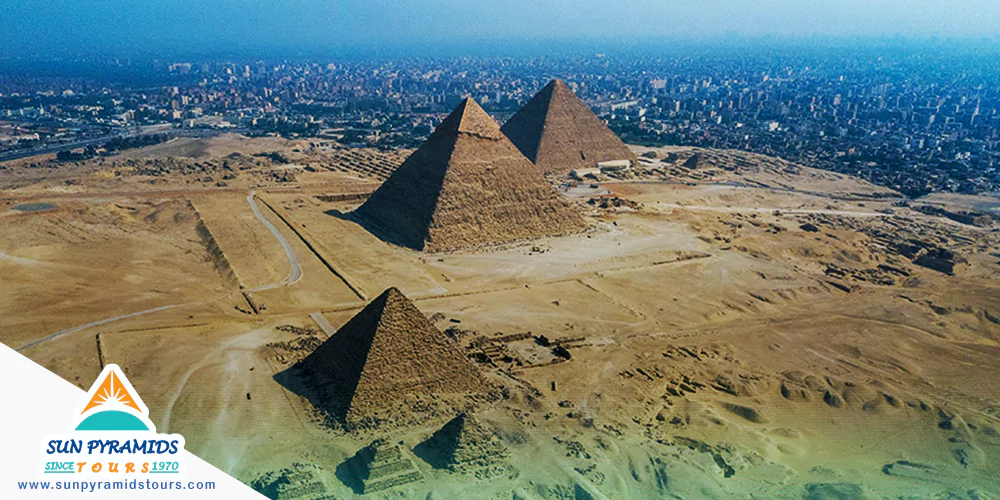
Nestled in the heart of the Western Desert, the complex is a mere 9 km (5 mi) westward journey from the majestic Nile River. It’s situated 13 km (8 mi) southwest of the bustling Cairo city center. Moreover, it enjoys proximity to the legendary city of Memphis, adding to its allure.

Unveiling the Sacred Purpose of the Giza Pyramids

The Giza Pyramids Complex served as more than just a burial site. It was a carefully crafted portal to eternity, designed with the primary objective of safeguarding the mummified remains of the revered Pharaohs. This ensured that their spirit, or “Ka,” could reunite with the body, undergo a complete transformation, and ascend to the afterlife.
The ancient Egyptians, including the royal family, viewed death as a passage to another realm referred to as the fields of reeds. The pyramid, a symbol of their profound belief, functioned as a protective shield for the Pharaoh’s body and spirit, facilitating their transition to become the sovereign of the departed.
The Pyramids of Giza were equipped with all the essentials required for the Pharaoh’s voyage in the afterlife, reflecting the detailed planning involved in preparing for this sacred journey.

The Celestial Layout of the Giza Pyramids Complex

Spanning an expansive area of 16,203.36 hectares (62.5615 sq mi), the Giza Pyramids Complex stands as a monumental necropolis, hosting the three iconic pyramids of Giza. Each of these grand structures is accompanied by a smaller complex, serving as the final resting place for their respective queens and offspring, a unique feature of this ancient site.
The complex is renowned for the Great Sphinx, Egypt's celestial guardian, positioned with grandeur to the east. Scholars have proposed that the layout of the Pyramids aligns with the Orion constellation, a theory that adds a layer of mystery and conspiracy to this ancient wonder, sparking further interest and exploration.
In addition to the main pyramids, the complex is decorated with smaller satellite structures known as the queen’s pyramids, valley pyramids, and causeways. Unfortunately, these magnificent structures have been subject to theft and tomb raiding, causing uncorrectable damage to their interiors and exteriors, and the heartbreaking loss of treasures and mummies.
Surrounding the Giza Pyramids is a large stone wall that once sheltered the workers who built these awe-inspiring structures. This area, known as the workers’ village, dates back to the middle of the 4th Dynasty (2520 – 2472 BC).

Pyramid Construction: The Orion Connection
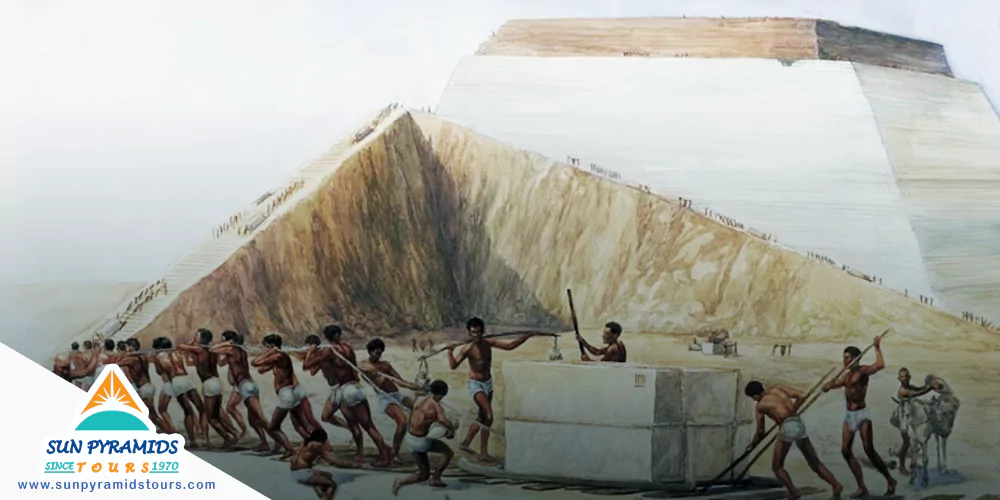
The construction of the Giza Pyramids, a question that has captivated minds for centuries, is a complex puzzle. The general theory, which we will delve into in this article, suggests that these architectural marvels were erected by transporting massive stones from quarries and accurately positioning them within the Giza complex.
The innovative architects employed sophisticated techniques to survey the site, strategically placing the initial layer of stones and building the pyramids on horizontal levels. Each limestone block, weighing approximately 2.5 tons, was stacked with precision, creating a symmetrical and balanced structure.
Remarkably, all sides of the three Giza pyramids align astronomically to the east-west and north-south axes within a minuscule fraction of a degree, echoing the Orion constellation correlation theory. This theory suggests a connection between the pyramids' layout and the stars in the Orion constellation, showing a deep understanding of astronomy by the ancient Egyptians.
Even after more than 4500 years, the Giza Pyramids complex stands tall, a testament to human creativity and resilience that continues to captivate and inspire visitors from across the globe. It is a timeless testament to our shared human heritage, a symbol of our enduring legacy.

The Great Pyramid of King Khufu

The Great Pyramid, the solo survivor of the Seven Wonders of the Ancient World, is a testament to the architectural precision and spiritual beliefs of its time.
Constructed for King Khufu during the Old Kingdom era between 2580 BC and 2560 BC, it stands as a monumental tribute to the King’s power and his faith in the afterlife. Known also by its Greek name, Cheops, this awe-inspiring building took two decades to complete.
For over 3,800 years, the Great Pyramid held the record as the world’s tallest structure, reaching a height of 147 m (481 ft.). This record was only surpassed in 1311 with the construction of the Lincoln Cathedral, underscoring the enduring legacy of this ancient marvel.
The pyramid was constructed using an astounding 2.3 million limestone blocks, each weighing 2.5 tons, amounting to a total weight of 57.5 million tons. A workforce of 100,000 laborers, working in shifts, employed a complex system of ramps and pulleys, a testament to the advanced engineering skills of the ancient Egyptians.
The Great Pyramid is not merely a colossal structure but a symbol of the precision and skill of its builders. Its sides rise at an angle of 51°52′ and are accurately oriented to the four cardinal points of the compass. This architectural masterpiece was designed by King Khufu’s vizier, Hemiunu, who harnessed all the resources of the Old Kingdom’s golden age to create a true wonder.
The interior design of the pyramid is its most fascinating aspect. It comprises three main elements: the King’s chamber, constructed entirely from granite, the Queen’s chamber, and the Grand Gallery. Each element contributes to the pyramid’s captivating allure, making it a must-visit destination for history enthusiasts and travelers alike.

King Khafra's Pyramid
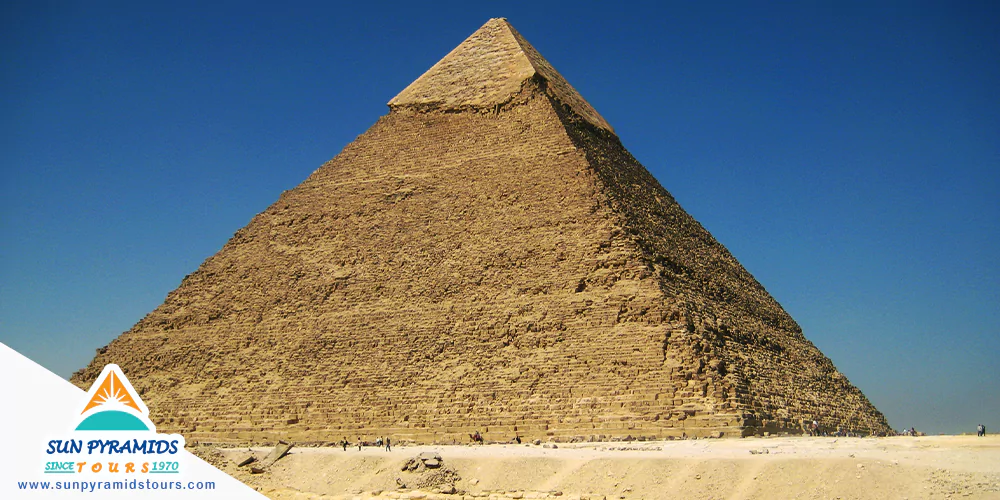
The second-largest pyramid in Egypt was constructed by King Khafra (2558-2532 BC) during the 4th Dynasty in 2540 BC. Known by the Greek name Chephren, this pyramid was the brainchild of Khafra, son of Khufu, who aspired to emulate his father's monumental achievement.
This limestone tower rises to a height of 136.4 m (448 ft.) on a base of 215.5 m (706 ft.) and boasts an angle of 51°50'24". Its elevated position and steeper inclination give it the illusion of being more significant than Khufu's pyramids.
The pyramid's forum is unique, decorated with a majestic array of casing stones that have withstood the test of time. Guarding the pyramid from the west is the iconic Sphinx, a mythical creature with the body of a lion and the head of King Khafra.

King Menkaure’s Pyramid

Constructed by King Menkaure, the sixth ruler of the 4th Dynasty, in 2510 BC, the smallest of the three pyramids stands not only as a testament to the architectural prowess of ancient Egypt but also as a solemn final resting place, a tradition carried on by his predecessors.
The pyramid, a testament to the grandeur of its time, is decorated with limestone on the exterior and red granite on the interior. Its impressive height of 61 m (204 ft.) and base of 108.5 m are not the only remarkable aspects. The sides of the pyramid, inclining at an angle of 51°20′25″, demonstrate the precision and design mastery of ancient Egypt.

The Great Sphinx: A Majestic of Ancient Egypt
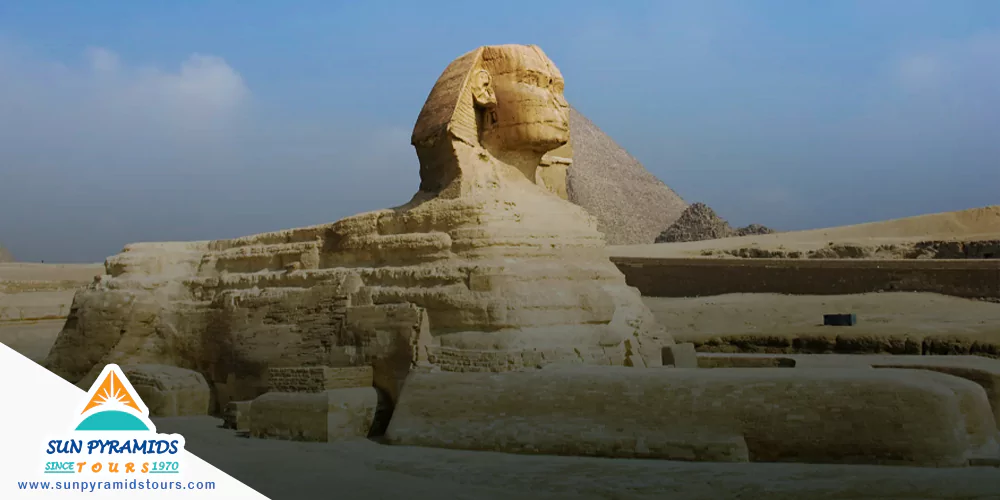
The Great Sphinx, a marvel of the ancient world, is a living testament to Egypt's rich cultural history. Its origins can be traced back to the Old Kingdom during the 4th Dynasty (2558 – 2532 BC), under the reign of Pharaoh Khafre.
Known as Hor-em-Akhet, or Horus of the Horizon, it stands as a beacon of the grandeur and creativity of the ancient world.
Renowned as the oldest and largest statue on Earth, this colossal structure was meticulously carved from a massive limestone rock into the shape of the mythical Sphinx.
Crafting such an enormous statue wasn't easy. It required the labor of thousands of workers and the use of sophisticated tools.
The Sphinx, with the body of a lion and the head of a man, likely represents King Khafre himself, symbolizing his wisdom and power. It stands impressively at a length of 73 meters (240 ft), a width of 19 meters (62 ft), and a height of 20 meters (66 ft).
The Sphinx has long been shrouded in mystery and speculation, with questions surrounding its age, original design, and true purpose. Despite these uncertainties, the Great Sphinx continues to captivate and inspire, standing as a timeless symbol of Egypt's rich heritage.

The Worker's Village
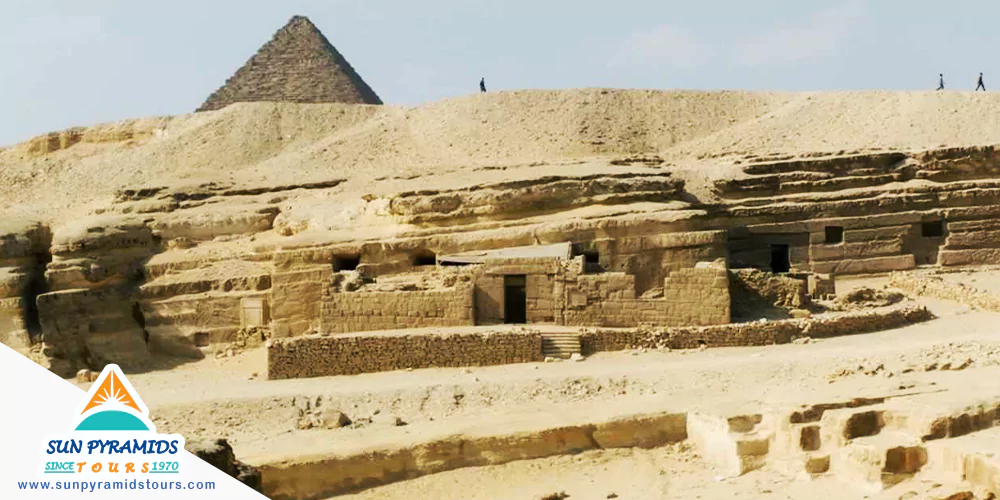
The Worker's Village, a significant archaeological site dating back to the middle 4th Dynasty (2520–2472 BC), was not just a bustling hub for over 10,000 workers. It was a testament to their unwavering dedication and hard work. These workers, including quarry workers, metalworkers, architects, carpenters, haulers, and masons, dedicated more than three decades of their lives to the construction of the majestic Giza Pyramids.
Situated to the west of the city of Giza, this village was not just an operational headquarters. It was a symbol of the workers' status and well-being. The countless tombs of the pyramid builders stand as a testament to their status as well-compensated, well-nourished civil servants, as well as to their achievements and the respect they commanded.
Located southeast of the Khafre and Menkaure complexes, the village was not just a place of work but a community. It housed communal sleeping quarters, breweries, bakeries, and kitchens. The remains of these structures, along with the discovery of bread, beef, and fish, give us a glimpse into the workers' diet. The village also had a hospital and a cemetery, showing that the welfare of the workers was a priority.
The Worker's Village and the Giza Pyramids are not just architectural marvels but also treasure troves of ancient Egyptian art. The tomb art, rich in detail and symbolism, depicts scenes from daily life during this period. These include farmers tending their fields, livestock rearing, fishing, fowling, carpentry, metalwork, religious rituals, and burial practices. Each scene offers a fascinating glimpse into the past, revealing the customs, beliefs, and activities of the ancient Egyptians.

Uncover Egypt with Sun Pyramids Tours Adventure
Dive into the captivating history of Egypt with Sun Pyramids Tours. Seize the opportunity to unravel the mysteries of the Giza Pyramids Complex. Click here to explore our Giza Pyramids Complex private tour packages and enchanting Nile river cruises. Embark on a journey of a lifetime to the land of the Pharaohs. Your adventure awaits!”
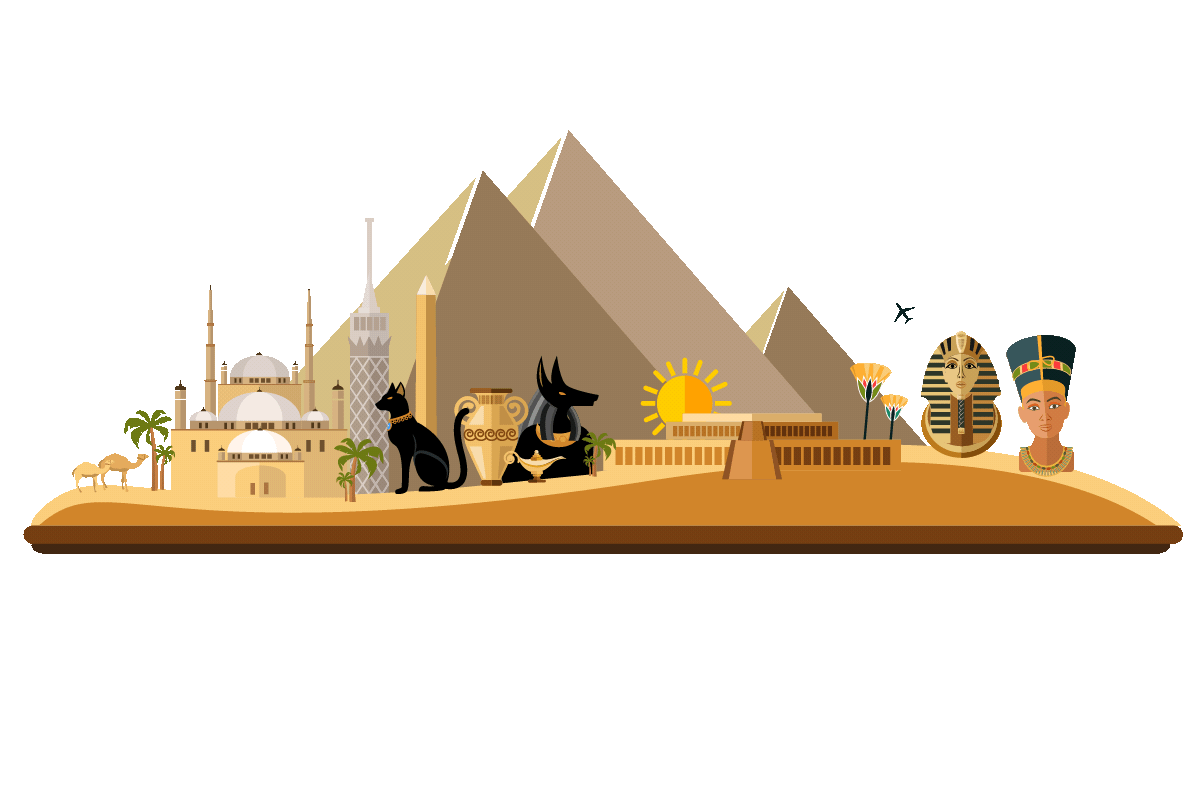
.DvizhAGb.gif)
Plan your next adventure now
Related Tours
Frequently Asked Questions
See more

There are no frequently asked questions :)
Related Blogs

Plan A Trip to Egypt
+1 more
Ultimate Guide: How To Plan A Trip To Egypt

Christmas and New Year in Egypt
+1 more
Christmas and New Year in Egypt

Egypt Hidden Gems
+1 more
Egypt Hidden Gems

Abu Simbel Temple
+1 more
Abu Simbel Temple
Need help to Finding your Trip?
Offers
Make Trip
trips
Home


.webp)
.webp)
.jpg)


.jpg)







.webp)







.jpg)



.webp)

.webp)

